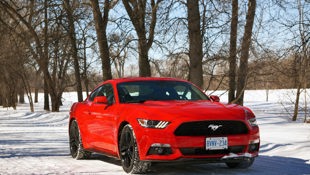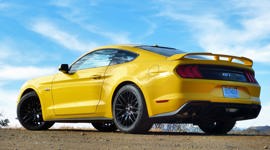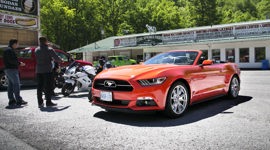“So how does it sound?”
That’s the number one question people ask as soon as I tell them I’m driving a four-cylinder Mustang. Mind you, this isn’t an ordinary four-pot pony car. The last time a Mustang was powered by a 2.3L engine it was an embarrassing bargain-priced wheezer that mustered a measly 105 hp. It was also 1993, and the mighty 5.0 of the time (which actually displaced 4.9 litres) was the attainable performance benchmark with 225 horses galloping forth.
But for 2015, the humble 2.3 has undergone quite a transformation. In fact, it only shares its cylinder count and approximate displacement with that old donkey of a motor. Ford has made a brand of its EcoBoost direct-injected, turbocharged engines in three-, four-, and six-cylinder configurations, as optional power in everything from a Fiesta to an F-150, and the new-for-2015 Mustang now joins the fray.
Fear not, though, if the idea of a Mustang with a diminutive engine just doesn’t work for you, because the four-pot isn’t even the base engine anymore. That honour belongs to the Mustang V6, which starts at $25,349, or $3,000 less than the least expensive EcoBoost. And while we’re looking at engine options, it should be noted that a base 5.0 starts the bidding at $37,349.
It would be nice if engine selection is where the decisions stop, but the V6 and EcoBoost Mustangs cater to distinctly different customers. It’s not that the V6 is weak – indeed, at 300 hp and 280 lb-ft of torque, it’s a base engine that any owner could brag about – it’s just that the packaging of the EcoBoost is such that those looking for real performance will need to check this box if they want a platform on which to build. Case in point: our tester was equipped with the performance package, which is not available on the V6.
Second Opinion: 2015 Ford Mustang EcoBoost Review by Justin Pritchard
On the EcoBoost, this $3,000 upgrade nets stiffer suspenders, extra cooling for track days, a strut tower brace, performance-oriented driver assistance settings (steering assist, ABS, and stability control), gauges for oil pressure and boost, upgraded brakes (four piston in front), 19-inch alloys, and performance rubber. The GT performance pack gets even more in the form of six-piston Brembo brakes, a rear strut tower brace, and revised front aerodynamics to provide cooling to the front brakes.
The performance packs are icing on the cake that represents a fundamental change for all 2015 Mustangs in the form of an independent rear suspension. And that, folks, is the single biggest improvement 2015 sees. The dearly departed live rear axle in the old car was a feature I loved to hate, a nod to cost-saving measures that had finally overstayed its welcome. It’s about time, too, because last year’s Mustang handled mid-corner bumps with all the grace of an unloaded pickup truck rounding a bend on a washboard gravel road.
The independent suspenders in the new car, on the other hand, allow it to handle the pockmarked streets of Winnipeg gracefully without introducing a hint of cushy to the car’s handling repertoire. The front suspension has been redesigned with a new subframe up front to provide stiffer suspension mounting points. The result: a transformation of the car’s character without sacrificing its essence.
So, to a starting price of $28,349, Ford added the performance pack, as well as a security package, reverse park assist, all-weather floor mats, and Recaro cloth seats, for an as-tested price of $35,399 before taxes.
But back to the EcoBoost: with the aid of direct injection and a force-fed intake courtesy of a twin-scroll turbocharger – the latter a first for Ford – the 2.3L four doles out 310 hp and 320 lb-ft of twist, besting the V6 while at the same time achieving more favourable Transport Canada consumption numbers: 9.2 L/100 km combined compared to 11.2 for the V6 and 12.5 for the V8. It also represents the highest specific power output (hp per litre of engine displacement) of any Ford production engine.
Torque delivery is at least as important as the peak output value, and is key to providing this pony car with the responsiveness and flexibility that it needs to have to be taken seriously. And as with all Ford EcoBoost engines, the Mustang’s torque curve is broad and the system is capable of delivering robust power no matter where in the rev range its turning.
Also key to delivering worthy performance (to this driver, at least), is the availability of a proper manual gearbox, and in this regard, Mustang delivers. A six-speed manual is standard equipment across the board, no matter which engine is selected. And in the EcoBoost, it’s a winner: short, notchy throws require shifts to be a bit deliberate, but in a way that completely suits the character of the car. Shoppers would be doing themselves a disservice to skip over the manual without at least trying it. The clutch is stiff, requiring some weight to disengage, but again, it’s in a manner that is consistent with the car’s character. This isn’t a BMW, folks, nor does it aspire to be.
From the driver’s seat, the Mustang has been improved substantially. As with the rear suspension, the passenger cabin is no longer a slave to value engineering. Improved materials contribute to an upscale look, without treading into the luxury world. Design-wise, it’s a tasteful step forward for the Mustang, preserving the dual cowl look but making it more streamlined and incorporating all of the available tech in a cohesive manner. The three-spoke wheel and gauge cluster contain enough brightwork to eliminate the word “budget” from first impressions, dispensing with the near-illegible retro font on the gauges, replacing them with clearer numbers. Our tester’s optional Recaro seats wore tasteful cloth and were supremely supportive.
Heated seats would have been nice, though. And since our tester was rather sparingly optioned, it lacked the large touch screen available on higher-spec models (check out the EcoBoost Premium model to get this stuff).
But it’s the Mustang’s exterior that leaves me a bit conflicted. This is a big car – at 4,783 mm long, it’s a significant 226 mm longer than my family wagon, and that long, wide hood dominates the car’s styling. That on its own is hardly worthy of criticism; it’s a pony car after all. But then the car tapers toward the long, pointy rear in kind of a teardrop shape, which I don’t think is the look Ford was after. It’s most obvious in the rake of the smallish taillights above the relatively large rear bumper. Overall, it leaves me with the impression that the styling of the previous generation Mustang was more successful in its cohesiveness.
Plus, I know this car isn’t designed with families in mind, but access to the rear seat is more cumbersome than it should be, because the front seats tilt but they don’t slide forward when the access lever is pulled.
On the plus side, the Mustang’s trunk is big enough with a wide enough opening that it swallowed my teenage daughter’s hockey bag without breaking a sweat.
But at the end of the day, it’s about the drive. And the sound.
The Mustang’s cockpit is perhaps a more of an intimate space than one would expect from a pony car, but that helps when the task of driving is at hand. It was easy to get comfortable; those Recaro sport seats are supportive and the controls fall easily to hand. The shifter, in particular, has been moved closer to the driver and the pedals are well placed for heel-and-toe duty.
Having been delivered to Winnipeg near the end of the winter season, our tester was shod with studded Nokian Hakkapeliitta 8 rubber, which was a learning experience for sure. The temperature was in the minus-20 range when I picked the car up, and the tires didn’t seem to have a lot of traction on the cold, dry pavement. Or, the car has sufficient torque to break rear wheel traction just off idle. I suspect it’s a bit of both, since I was able to break traction in third gear at 60 km/h in those temperatures. But I quickly became accustomed to the EcoBoost’s power delivery and we became much better friends in short order. Plus, as the temperature rose sharply that week, up to the zero degree mark, the Nokians found better footing on the dry pavement.
Suffice to say that city conditions in sub-zero temperatures hardly make for an environment in which to test a performance car’s capabilities. Nevertheless, the improvements that Ford’s design team has made to the car’s intrinsic goodness are evident even during the day-to-day drive.
The blown four doesn’t bellow like a V8, but it does manage a unique growl of its own [Thanks in part to the fake engine noise piped into the cabin - Ed]. It’s smooth, for a four-banger, and has a torque plateau that’s as flat as my home province of Manitoba. Working the Mustang through its gears, it’s clear that people will have to revise their expectations of what this car should sound like. There’s no imposing exhaust note, no tenor wail coming from under the hood. In exchange, owners get this healthy performance and can, if they so choose by disciplining their right foot, achieve commendable performance numbers. In primarily city driving, I averaged a little more than 12 L/100 km in mild winter weather.
It’s more than just engine technology: EcoBoost specific active grille shutters close off the supply of fresh air, directing air around the engine compartment rather than through it when cooling requirements are reduced. This technology complements the new car’s more slippery shape.
Driver information has been enhanced in the new car with the addition of TrackApps, Ford’s name for a suite of performance tracking abilities that, while intended for track use, make for some good entertainment while slogging through traffic as well.
The new Mustang brings with it some serious tech in the form of a redesigned suspension and the new EcoBoost four-cylinder engine that is a worthy option for those looking for an otherwise elusive combination of performance and efficiency.
As for the sound, well, it would have been nice to see something a little more aggressive with this EcoBoost out of the box.
| Warranty: 3 years/60,000 km; 5 years/100,000 km powertrain; 5 years/unlimited distance corrosion perforation; 5 years/100,000 km 24-hour roadside assistance Competitors: |
| Model Tested | 2015 Ford Mustang EcoBoost |
|---|---|
| Base Price | $27,999 |
| A/C Tax | $100 |
| Destination Fee | $1,600 |
| Price as Tested | $35,399 |
|
Optional Equipment
Pricing:
$5,700 (Performance pack, $3,000; reverse park assist, $350; security package, $700; winter floor mats, $150; Recaro seats, $1,500)
|
|































